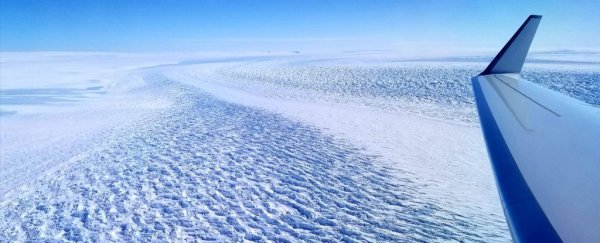The ice sheet that sits atop Earth's deepest land canyon stands on shaky ground.
A detailed mapping of Denman Glacier in East Antarctica - the most scrupulous to date - has revealed a precarious foundation, the shape of which could leave the heart of this glacier incredibly vulnerable to climate change.
In nearly three decades, Denman Glacier has already retreated some five kilometres (nearly three miles) and lost over 250 billion tons of ice. In the worst case scenario, the damage could be much greater.
Unlike other glaciers in Antarctica, Denman is particularly thick - sitting on a canyon 3,500 metres below sea level. What's more, it's sloped in the opposite direction, facing away from the ocean instead of towards it, and that could make all the difference.
That might sound counterintuitive. Wouldn't this cause the glacier to be more stable, after all? In fact, no. This shape allows more warm ocean water to slide down and infiltrate crucial parts of the glacier's foundation.
If the point where the glacier floats on the sea - known as the grounding line - continues to retreat all the way back to the Aurora Subglacial Basin, some 160 kilometres or 100 miles inland, the situation could spiral out of control.
As the line moves farther back, researchers say it will inevitably meet thicker and thicker ice, allowing increasing amounts of meltwater to flow out into the ocean.
"Because of the shape of the ground beneath Denman's western side, there is potential for rapid and irreversible retreat," says NASA geoscientist Virginia Brancato, "and that means substantial increases in global sea levels in the future."
If the entire glacier collapses, the authors predict it could cause 1.5 metres (5 feet) of sea level rise, and that's no small amount in the grand scheme of things.
While West Antarctica is generally considered the most vulnerable to melting, these results support the idea that East Antarctica could be more vulnerable than we once thought.
"The ice in West Antarctica has been melting faster in recent years, but the sheer size of Denman Glacier means that its potential impact on long-term sea level rise is just as significant," says Earth system scientist Eric Rignot at the University of California Irvine.
Using satellite data from the Italian Space Agency between 1996 and 2018, the study reveals a clear asymmetry in Denman Glacier's grounding line.
Compared to the eastern side of the glacier, which is more narrow, the western flank looks far more vulnerable, showing a steep trough-like appearance that could spell trouble for rapid melting.
With a vigorous ocean continuing to lap at the edges of this ice sheet, the slope could act like a sort of slide, taking the ocean and the melting ice further and further inland - a runaway effect that isn't often considered in today's ice sheet models.
"This study provides additional evidence that, based on current knowledge, we cannot exclude at least a slight possibility of much more sea-level rise than the most-likely value in [Intergovernmental Panel on Climate Change] projections," Richard Alley, a glaciologist at Pennsylvania State University who did not work on the study, told The Washington Post.
At the end of last year, research revealed for the first time that the Denman Glacier covered the world's deepest land canyon - nearly as deep as the average depth of the ocean, and eight times deeper than the shores of the Dead Sea.
That's how much ice we stand to lose, and we only just realised.
The study was published in Geophysical Research Letters.
